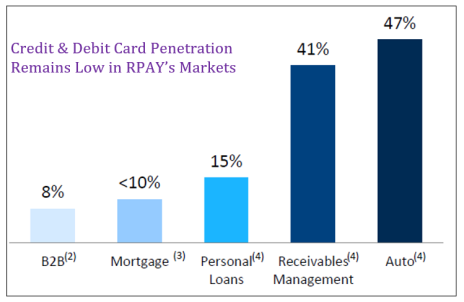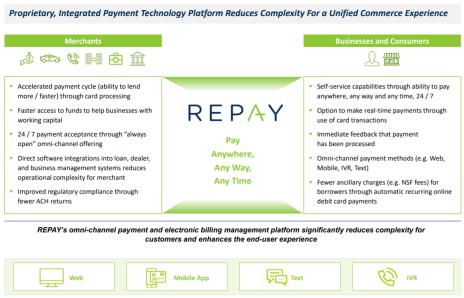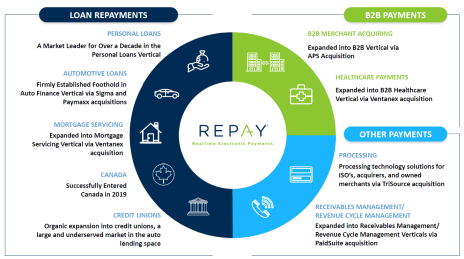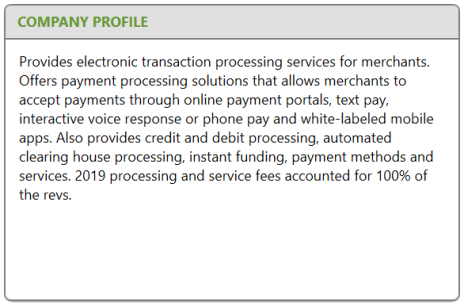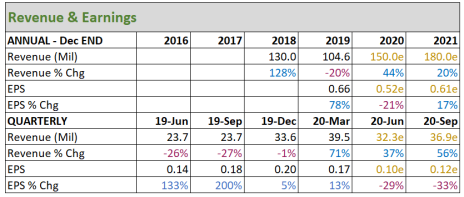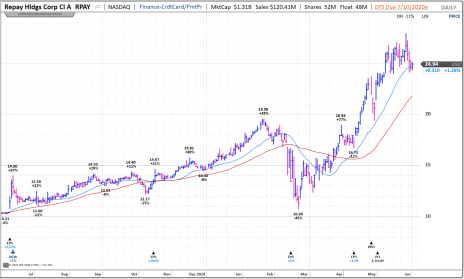Digital payments were already a big trend prior to Covid-19. But the pandemic has pulled forward demand for solutions that help businesses pay and get paid whenever, wherever, and however.
Today we’re profiling a small company that specializes in payment processing solutions. It’s relatively new to the public markets and has a market cap well under $2 billion.
While areas of its busieness have been harmed by the pandemic the big-picture story remains great. And management reported record sales activity in both March and April. And the stock’s looking great.
All the details are inside this month’s Issue. Enjoy!
Cabot Small Cap Confidential 254
[premium_html_toc post_id="209237"]
The Big Idea
If there was ever any doubt that digital payments is a big trend the coronavirus pandemic has squashed the argument.
Locked up at home, people have still needed to buy things and pay their bills. Businesses, from car and boat dealerships to retailers to mortgage servicers, have still needed a way to efficiently collect.
Historically, there has been some reluctance to move to digital payments because of transaction costs. That concern had been dwindling anyway, and Covid-19 demolished it. The time and effort required to track down and collect payments is huge compared to the smallish fees paid to collect payments in near real-time.
New technologies, such as push to payment, means card payments can allow funds to be accessible within 30 minutes at the most, and often within mere seconds.
That’s a huge advantage over the multi-day waiting period of ACH and paper checks.
Plus, we’re seeing steadily growing usage of debit cards for big ticket items and recurring debt payments. These are situations in which credit cards often can’t be used, but debit cards can. Businesses are even starting to offer debit card recurring charges as the default payment option.
The bottom line is that the world is now moving even more quickly toward digital payments than it was prior to the pandemic.
Businesses and consumers want to pay and get paid quickly, securely and easily. They need an omni-channel payments processor that works over text, voice, mobile and web in order to get the job done. None of that points toward a rebound in usage of cash and checks!
Today’s addition to the portfolio is a pure-play small-cap company that’s powering the digital payments movement forward.
The Company
Repay Holdings (RPAY) is a $1.3 billion market cap company specializing in digital payment processing solutions.
The Atlanta, Georgia-based company was founded in 2006 by John Morris and Shaler Alias, both of whom remain with the company today. It was taken public in July 2019 through a merger with the special acquisition company (SPAC) Thunder Bridge Acquisition.
Repay is growing organically at a roughly 20% clip and through targeted acquisitions, which are bumping up the total growth rate. The strategic growth map is all about pursuing large and growing market verticals that have very specific transaction processing needs.
Current market verticals total over $2.3 trillion annually just in the U.S. They include personal loans, automotive loans, mortgage loans, business-to-business (B2B) payments and accounts receivable (AR) management.
All these markets have been slow to adopt digital payment technologies because of unique market characteristics. For instance, loan repayments don’t permit credit cards. That has hindered adoption, but debit cards are increasingly allowed for loan payments.
Repay is also pursuing the massive, trillion dollar B2B payments vertical, where transactions have historically been made via ACH or check. But now businesses are embracing electronic payment solutions across various channels – web, mobile, text, voice – and this is fueling demand for Repay’s solutions, and creating opportunities to bring new products to market.
The company has enjoyed rapid growth because of industry tailwinds, a purpose-built platform that’s dependable and secure, and because it has been able to land integration agreements with key software providers. These integrations, of which there are well over 70, span loan, dealer and collection management systems, as well as enterprise resource planning (ERP) software systems.
Major integration players like Sage and SAP, help generate a lot of buzz. But the dozens of smaller ones are substantial as well. Repay recently integrated its platform with Katabat’s debt management software, which is used by banks and debt collection agencies.
A recent partnership with Inovatec Systems, a provider of cloud-based lending solutions for financial institutions, allows companies on that system to accept debit cards, credit cards and ACH payments through Repay’s multiple consumer-facing channels.
Collectively, these integrations help Repay’s sales team pursue new clients because customers will often only consider a payments provider that has already integrated with their main ERP system. They also provide a knowledge and data conduit to help Repay understand consumer trends.
Repay is growing total card payment volume at a roughly 44% pace. New customers aren’t typically disclosed, but management recently announced a major deal with Mercedes Benz, for which Repay will be the payment processing provider for Mercedes-Benz financial services. This is just the latest example of a major brand delivering broad payment options to customers – across mobile, phone and the web – using Repay’s platform.
Products & Platform
The heart of Repay’s business is its payment technology platform. This is the hub through which money, data, compliance, and customer service flows.
The platform allows for rapid card processing, which helps businesses with working capital needs and drives growth in processing volumes. It permits omni-channel payments across web, mobile, voice and text. And it helps curb fees by allowing recurring online debit card payments.
Altogether, the platform facilitates payments for over 14,000 merchants in a wide variety of industries spanning loan repayments, B2B payments and receivables management.
Here’s a quick look at a few of the markets in which Repay is active.
Personal Loans
This is currently Repay’s largest market. It is mainly comprised of installment loans that consumers make for everyday expenses. Repay helps to make sure those payments arrive on time, every time. With Covid-19 there has been a decrease in loan originations as consumers pulled in spending, but on the most recent conference call management said origination volumes have begun to bounce back and that it was still consistently processing payments in the existing portfolio. Management also said this vertical is benefiting from the shift to debit card payments, which is more than offsetting declines in originations.
Automotive Loans
Repay’s automotive loans business includes subprime, near-prime and prime auto loans, title loans and buy-here-pay-here loans. Historical data, including from during the Great Recession, show that consumers tend to prioritize these loans.
Mortgage Loans
With the acquisition of Ventanex, Repay became a player in the mortgage servicing market. There is some potential that payments here could be curbed in the near-term due to people pausing their mortgages with the aid of the CARES act, but longer-term this remains an attractive market given the repetitive nature of significant payments.
Business-to-Business (B2B)
Repay is playing both sides of the ball in the growing B2B digital payments market by enabling both accounts receivables (AR) for a diversity of businesses (manufacturing, wholesale, distribution, etc.) as well as accounts payable (AP) for healthcare organizations.
The AR side represents the bulk of B2B revenue and is represented by the acquired APS business, which brought in merchant acquiring and seven key ERP integrations with accounting software (Sage, SAP, etc.). Merchant acquirers allow businesses to accept credit and debit card transactions and they handle all the communications between a business and the bank from which the funds are coming.
The AP side is represented by the Ventanex acquisition and is specific to healthcare payments. In this area Repay is looking to grow its business by adding third-party administrators, as well as automation software capabilities.
Overall, Repay is generating roughly 20% of revenue in B2B and is growing this business by around 20%. It is looking to grow in this market both organically and through future acquisitions.
Growth Initiatives
Mergers & Acquisitions (M&A)
Repay is looking to do more M&A in existing verticals, especially B2B. It also sees opportunities in the Enterprise Resource Planning (ERP) space, as well as in AP and AR automation.
Here’s a quick look at the three most recent acquisitions:
TriSource Solutions: Repay acquired TriSource on August 13, 2019 for roughly $65 million. TriSource provides back-end transaction processing services to independent sales organizations (ISOs), which includes a healthy mix of retailers. This business has declined as a result of Covid-19.
APS Payments: Repay snapped up APS on October 14, 2019 for approximately $60 million, including performance payments. APS is an integrated payments provider focused on the B2B market, and brought a number of key ERP integrations with it.
Ventanex: Ventanex is an integrated payment solutions provider to consumer finance (including mortgage servicers) and B2B healthcare verticals. Repay acquired it on February 10 for up to $50 million, including $14 million of performance payments.
Geographic Expansion
Repay sees expansion in Canada as a natural extension of what it’s doing in the U.S. In April management announced a partnership with TurnKey Lender, a cloud-based lending software for evaluating borrowers across a wide variety of loan verticals. TurnKey has a network of over 300 lenders in the U.S. and Canada. Repay is also moving forward with a host of key integrations for the Canadian market, including NovaTech, an end-to-end lease and loan automation software solution used by 23 Canadian lenders, and which represents roughly 80% of the prime market.
The Business Model
Repay generates revenue through volume-based payment processing fees and related fixed-per-transaction fees. This is a volume game. Growth drivers include the dollar volume and number of transactions, management’s ability to land new merchants and get them onboard quickly, its ability to integrate acquisitions, and its ability to develop new products that drive higher volume.
Roughly 50% of new customers come via integration partners while a direct sales force drives the other 50%. The biggest operational costs besides SG&A, and depreciation and amortization, are the costs of services related to card processing volumes.
The Bottom Line
Repay’s historical financial statements are a challenge to analyze for three reasons. First is the way the company came public through a combination of subsidiaries with Thunder Bridge acquisition in July 2019. Second is the adoption of the ASC 606 accounting standard for 2019, which affects how some revenue and expense items are reported, but doesn’t affect cash flow or profits. Because Repay didn’t need to restate 2018 financials it looks like revenue fell in 2019. It did not. Finally, Repay completed two significant acquisitions in 2019, plus one in early 2020. Naturally, these have the impact of pushing revenue higher, which distorts the growth rate further. In short, one needs to consider the circumstances behind the numbers because if you just look at the financial statements you won’t get a fully accurate picture of what’s going on.
All that said, 2019 was a huge year for Repay. It acquired both TriSource Solutions (back-end software) and APS Payments (B2B solutions). Using the same accounting standard that was used in 2018, Repay grew revenue by 28%. However, actual reported revenue under the new accounting standard was $105 million, which (somewhat incorrectly) implies a revenue decline of 20%. This will be the number we’ll compare 2020 results to. Card payment volume was up 44% to $10.7 billion, gross profit rose 43% to $79 million and adjusted EPS was $0.66.
In the first quarter of 2020, reported on May 11 (and for which there are no accounting rule changes), revenue was up 71% to $40 million. The combination of the three recent acquisitions accounted for roughly 32% of Q1 revenue. Card payment volume rose 58% to $3.8 billion, gross profit was up 60% to $29 million and adjusted EPS was $0.17.
Analysts currently see revenue growing by around 44% to $150 million this year, though back in March management suggested $155 million to $160 million was their expectation. Acquisitions will surely affect the future growth rate. Repay is also expected to be profitable going forward, with adjusted EPS near $0.52 in 2020.
Risk
Data Breach: One of Repay’s core competencies is providing secure digital payments. Should any data security arise Repay could suffer reputational damage.
Drop In Card Payments: Repay’s growth is largely tied to growth in use of debit cards from Visa, MasterCard and Discover. If consumers and businesses reduce use of these cards Repay’s processing volume could shrink.
Integration: Integrations are a critical part of the story as they allow Repay to reach customers. If it has a hard time growing future integrations, and/or smoothly working through the technology end of things, growth could be harmed.
Evolving Technology: The digital payments market is rapidly changing and there are many players and technologies. Repay will need to keep innovating internally and bringing in the right assets through acquisitions to remain competitive.
Acquisition Risk: Part of the growth story relies on acquired technologies. If Repay stumbles on the M&A front growth could be harmed.
Reliance On Sponsor Banks: Repay is not a bank so it isn’t eligible for membership in Visa, MasterCard, Discover and other payment networks. Instead, it relies on sponsorship from sponsor banks, who have a great deal of discretion in approving elements of Repay’s business practices.
Debt/Interest Rate Risk: Repay carries $246 million in debt, so it is exposed to interest-rate risk. However, leverage is well within debt covenants and the leverage ratio is lower than larger players (FIVN, GPN, FIS).
Competition
Repay faces a competitive market with many players, including ACI Worldwide/Speedpay, InstaMed/JP Morgan, Open Edge/Global Payments, ACI Worldwide, Electronic Payment Providers/BillingTree, Bank of America Merchant Services, Elavon/U.S. Bancorp, Wells Fargo Merchant Services, WorldPay, and Total Systems Services, among others.
The Stock
Trading Volume: RPAY’s daily average volume has been around 880,000 shares in recent months. That average has been pulled up by a few very heavy days (4 to 6 million shares each) when RPAY completed a secondary offering, announced a warrant redemption and was added to the Russell 2000. With over $20 million worth of the stock trading hands on many days I don’t expect our subscriber group will move the stock.
Historical Price: RPAY came public last July when it merged with Thunder Bridge Acquisition. Prior to the announcement Thunder Bridge was trading for just over 10. Afterward, RPAY surged to 14, pulled back to 11, then worked its way back to 14. By the end of 2019 RPAY was trading near 15. It then rallied nearly to 20 by mid-February. The market crash pulled it down to 10.7, then a choppy recovery had the stock at 19 by early May. A solid Q1 report and a well-received secondary, priced at 20 in early June, was taken mostly in stride. RPAY jumped above 24 on June 8 and has since been chopping around in the 24 to 28 range.
Valuation & Projected Price Target: RPAY currently trades at roughly 8 times 2021 estimated revenue on an enterprise value basis. We could see that metric climb up toward 10. However, the stock’s real driver will be growth in top-line revenue and earnings growth. My near-term price target is 33, but I expect the stock to climb well beyond that level longer-term.
Buy Range: Look to buy in the mid-20 range in the near term.
The Next Event: The next quarterly earnings call should be held around the second week of July.
Note on Financials: Due to change in accounting standard in 2019 RPAY’s reporting of revenue and expenses changed, giving the impression revenue declined in 2020. That’s not entirely accurate since the change was purely mechanical in nature and had nothing to do with the actual business. The quarter ending March 2020 was the first quarter to reflect an “apples-to-apples” comparison.
Updates on Current Recommendations
| Stock Name | Date Bought | Price Bought | Price on 7/1/20 | Profit | Rating |
| AppFolio (APPF) | 6/2/17 | 30.45 | 167.45 | 450% | Hold |
| Arena Pharmaceuticals (ARNA) | 2/2/18 | 38.93 | 62.47 | 60% | Buy |
| Avalara (AVLR) | 2/1/19 | 40.05 | 139.20 | 248% | Buy |
| Cardlytics Inc (CDLX) | 9/6/19 | 37.97 | 66.84 | 76% | Hold |
| Everbridge (EVBG) | 12/2/16 | 15.51 | 147.97 | 854% | Buy |
| EverQuote (EVER) | 6/7/19 | 11.69 | 59.51 | 409% | Hold 1/2 |
| Fiverr Intl (FVRR) | 3/5/20 | 32.32 | 75.20 | 133% | Hold 3/4 |
| Goosehead Insurance (GSHD) | 9/7/18 | 31.35 | 75.56 | 141% | Hold 3/4 |
| Inspire Medical (INSP) | 10/4/19 | 58.54 | 87.50 | 49% | Hold |
| Karyopharm Therapeutics (KPTI) | 5/7/20 | 19.49 | 19.25 | -1% | Buy |
| Palomar Holdings (PLMR) | 6/4/20 | 82.34 | 87.97 | 7% | Buy |
| Repay Holdings (RPAY) | New | — | 24.94 | — | Buy |
| Q2 Holdings (QTWO) | 4/1/16 | 23.81 | 87.64 | 268% | Buy |
| Repligen (RGEN) | 11/2/18 and 12/31/18 | 59.19 | 124.19 | 110% | Buy |
Please email me at tyler@cabotwealth.com with any questions or comments about any of our stocks, or anything else on your mind.
Glossary
Buy means accumulate shares at or around the current price.
Hold means just that; hold what you have. Don’t buy, or sell, shares.
Sell means the original reasons for buying the stock no longer apply, and I recommend exiting the position.
Sell a Half means it’s time to take partial profits. Sell half (or whatever portion feels right to you) to lock in a gain, and hold on to the rest until another ratings change is issued.
The next Cabot Small-Cap Confidential issue is scheduled for August 6, 2020.
Cabot Wealth Network
Publishing independent investment advice since 1970.
CEO & Chief Investment Strategist: Timothy Lutts
President & Publisher: Ed Coburn
176 North Street, PO Box 2049, Salem, MA 01970 USA
800-326-8826 | support@cabotwealth.com | CabotWealth.com
Copyright © 2020. All rights reserved. Copying or electronic transmission of this information is a violation of copyright law. For the protection of our subscribers, copyright violations will result in immediate termination of all subscriptions without refund. No Conflicts: Cabot Wealth Network exists to serve you, our readers. We derive 100% of our revenue, or close to it, from selling subscriptions to its publications. Neither Cabot Wealth Network nor our employees are compensated in any way by the companies whose stocks we recommend or providers of associated financial services. Disclaimer: Sources of information are believed to be reliable but they are not guaranteed to be complete or error-free. Recommendations, opinions or suggestions are given with the understanding that subscribers acting on information assume all risks involved. Buy/Sell Recommendations: All recommendations are made in regular issues or email alerts or updates and posted on the private subscriber web page. Performance: The performance of this portfolio is determined using the midpoint of the high and low on the day following the recommendation. Cabot’s policy is to sell any stock that shows a loss of 20% in a bull market or 15% in a bear market from the original purchase price, calculated using the current closing price. Subscribers should apply loss limits based on their own personal purchase prices.


